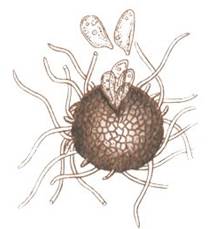
4.6 Powdery mildew
The causative agent of the disease is the fungus Erysiphe graminis DC., synonym: Brumeria graminis (DC) Speer., which affects wheat in its forma f. sp. tritici March.
The disease manifests as a white, powdery substance on the leaves, internodes of stems, and glumes, consisting of conidiophores and conidia of the fungus (Figure 67). These conidia are colourless, unicellular, and typically cylindrical or barrel-shaped, with dimensions ranging from 25 to 40 micrometers in length and 8 to 10 micrometers in width. They form extended chains at the end of the mycelium. During the wheat growing season, the fungus produces several cycles of conidial formation, promoting rapid disease transmission. Over time, the powdery layer becomes more compact, taking on a greyish, felt-like appearance, while brown lesions appear on the mycelium. These represent the fruiting bodies of the fungus, known as cleistothecia or cleistocarpia, which are spherical and covered with numerous appendages. Inside these structures, 8-16 asci are formed, each containing 4-8 elliptical ascospores, measuring between 20 and 23 micrometers in length and 11 to 13 micrometers in width (Figure 68).

Figure 67 - Wheat leaves affected by powdery mildew

Figure 68 - Cleistothecia of the fungus Erysiphe graminis
Distribution and harmfulness. Long-term observations have shown that powdery mildew is widespread on winter and spring wheat in the forest-steppe zone of northern Kazakhstan, significantly developing in irrigated lands in the southeast and southern regions.
Infection by powdery mildew causes a decrease in the leaf area available for photosynthesis and a reduction in the weight of the wheat grains. Additionally, it lowers the total carbohydrate levels, largely because of increased respiration, diminished photosynthetic capacity, and reduced activity of protease enzymes, while the total nitrogenous compounds increase (Vasyagina et al., 1968).